Food marketing in the digital age: A conceptual framework and agenda for research
The next few years will see a dramatic expansion of digital food and beverage marketing. The food industry is at the forefront of research and innovation in the interactive marketing arena, working with dozens of ad agencies, marketing firms, and high-tech specialists to design campaigns that take advantage of young people’s engagement with social networks, interactive games, mobile phones, online videos, and virtual worlds.1 Major brands have significantly increased their spending for online display advertising, exhibiting double- and in some cases triple-digit growth.2 For example, Coca-Cola’s spending was up 163 percent in 2009 from 2008; Dr. Pepper witnessed 427.9 percent growth; Kellogg’s was up 225.3 percent; PepsiCo 68.6 percent; Wendy’s 355.7 percent; General Mills 105.6 percent; and McDonald’s spent 47.4 percent more.3
Food marketers pay particularly close attention to ethnic minorities.4 As the fastest growing demographic sector, African-Americans and Hispanics are also important trendsetters who are influencing the consumption patterns, new media behaviors, and even many of the products of the broader youth market.5 Today’s minorities are predicted to become the majority, comprising almost half of all American youth by 2050.6
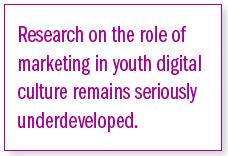 Yet, in the midst of this expanding digital marketplace, scholars still have little knowledge of just how these new forms of marketing are influencing child and adolescent behavior. The 2005 Institute of Medicine study noted the serious lack of research on digital marketing in the peer-reviewed literature.7 In the years since its publication, only a small number of scholarly studies have examined the health implications of interactive food marketing to young people.8 While a robust field has emerged to study digital media in young people’s personal, social, and political lives, academic research on the role of marketing in youth digital culture remains seriously underdeveloped.9 There is a large infrastructure of proprietary market research on children and interactive media, but these efforts are primarily intended to support commercial marketing and advertising.10 And though the academic field of marketing theory and research has generated a valuable body of literature on the digital marketplace, not much attention has been paid to children.11 The research and public debate over food marketing directed to children have focused almost exclusively on television commercials, as have the self-regulatory frameworks developed to address the issue.12 While the digital media and marketing system encompasses television, it exhibits a number of characteristics that make it distinctly different. The ability to engage with youth interactively takes the basic marketing paradigm to a new level, challenging the prevailing theories and methods that have guided media research in the past, and requires scholars to take a fresh look at how we approach the study of food marketing and its impact on young people’s behaviors. The traditional research emphasis on the content of television commercials and their effects on behavior and attitudes of young children is rooted in an earlier set of relationships in the mass media that are less applicable to contemporary practices. New models, research methods, and agendas are needed that can accommodate the changing nature of marketing in the digital era.
Yet, in the midst of this expanding digital marketplace, scholars still have little knowledge of just how these new forms of marketing are influencing child and adolescent behavior. The 2005 Institute of Medicine study noted the serious lack of research on digital marketing in the peer-reviewed literature.7 In the years since its publication, only a small number of scholarly studies have examined the health implications of interactive food marketing to young people.8 While a robust field has emerged to study digital media in young people’s personal, social, and political lives, academic research on the role of marketing in youth digital culture remains seriously underdeveloped.9 There is a large infrastructure of proprietary market research on children and interactive media, but these efforts are primarily intended to support commercial marketing and advertising.10 And though the academic field of marketing theory and research has generated a valuable body of literature on the digital marketplace, not much attention has been paid to children.11 The research and public debate over food marketing directed to children have focused almost exclusively on television commercials, as have the self-regulatory frameworks developed to address the issue.12 While the digital media and marketing system encompasses television, it exhibits a number of characteristics that make it distinctly different. The ability to engage with youth interactively takes the basic marketing paradigm to a new level, challenging the prevailing theories and methods that have guided media research in the past, and requires scholars to take a fresh look at how we approach the study of food marketing and its impact on young people’s behaviors. The traditional research emphasis on the content of television commercials and their effects on behavior and attitudes of young children is rooted in an earlier set of relationships in the mass media that are less applicable to contemporary practices. New models, research methods, and agendas are needed that can accommodate the changing nature of marketing in the digital era.
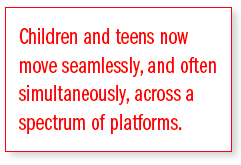 This report summarizes the research we conducted under a grant from the Robert Wood Johnson Foundation’s Healthy Eating Research program. In the following pages, we present a brief summary of our conceptual framework for understanding digital marketing and its role in promoting unhealthy food and beverages to children. We first provide a brief snapshot of key concepts of digital marketing and their implications for young people’s health. Next, we outline the challenges these concepts raise for researchers, and highlight relevant theoretical models for understanding how the new framework acts on children and youth; we also identify crucial gaps in our knowledge. Finally, we offer an agenda for future studies that can help us better understand the new marketing paradigm and support evidence-based policy-making.
This report summarizes the research we conducted under a grant from the Robert Wood Johnson Foundation’s Healthy Eating Research program. In the following pages, we present a brief summary of our conceptual framework for understanding digital marketing and its role in promoting unhealthy food and beverages to children. We first provide a brief snapshot of key concepts of digital marketing and their implications for young people’s health. Next, we outline the challenges these concepts raise for researchers, and highlight relevant theoretical models for understanding how the new framework acts on children and youth; we also identify crucial gaps in our knowledge. Finally, we offer an agenda for future studies that can help us better understand the new marketing paradigm and support evidence-based policy-making.
Six unique concepts define a framework for digital marketing
Intensive digital marketing campaigns for fast food, snacks, and sweetened beverages combine an integrated set of digital practices designed to engage children and youth continuously (see Figure 1). We have identified six defining concepts that constitute unique features of digital media and marketing.
Ubiquitous connectivity. Children and teens now move seamlessly, and often simultaneously, across a spectrum of platforms–from laptops to desktop computers to cell phones to televisions.14 Marketers design their campaigns to take advantage of young people’s constant connectivity to technology, their geographic locations, and the “fluidity of their media experiences. The ubiquitous nature of new media makes it difficult for researchers to take into account the entirety of an individual’s interaction with marketing. Neither the “medium” nor the “message” can be easily identified or isolated. While it is still important to understand how youth respond to individual media platforms and marketing appeals, they cannot be examined in isolation. Rather, researchers will need to find ways of assessing synergies across platforms, as well as how these platforms and the marketing content within them reinforce each other and create multiplier effects.
Engagement. In contrast to the passive experience of watching television, the increasingly participatory environment of interactive media facilitates active engagement.15 This is particularly the case for children and youth, whose enthusiastic involvement with social networks, blogs, text messaging, and online video makes them the most engaged demographic group.16 Engagement is a fundamental goal of contemporary digital marketing. Rather than simply exposing consumers to a particular message, product, or service, engagement means creating an environment in which young people are actually interacting with the brand, befriending the product, and integrating it into their personal and social relationships. Engagement also refers to the emotional connection between consumers and brands, which can be measured through a variety of techniques, including neuromarketing, which uses the tools of neuroscience to test the impact of marketing on the brain.17
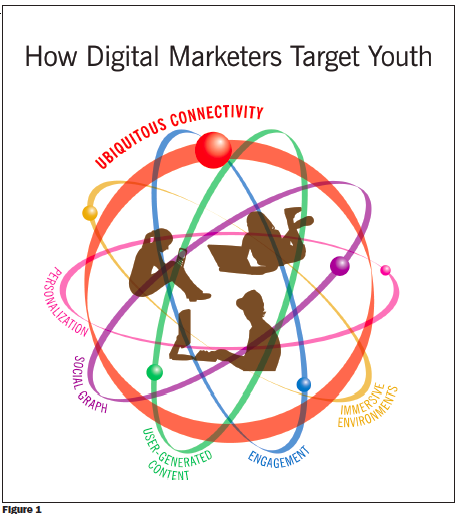 While researchers studying television food advertising could count the number of commercials a child might have seen during particular viewing periods, assessing engagement in the digital marketing context must take into account multiple elements, such as type and duration of interaction with a brand as well as degree of emotional involvement, in order to capture the full extent of a marketing campaign’s impact.
While researchers studying television food advertising could count the number of commercials a child might have seen during particular viewing periods, assessing engagement in the digital marketing context must take into account multiple elements, such as type and duration of interaction with a brand as well as degree of emotional involvement, in order to capture the full extent of a marketing campaign’s impact.
User-generated content. Digital technologies make it possible for marketers to enlist youth in creating and distributing brand-related content, including advertisements, products, and packaging for their favorite products. In this way, youth are not passive viewers of commercial messages, but active practitioners in the marketing enterprise. User-generated-media campaigns employ a variety of techniques to encourage consumers to become involved in creating marketing messages. In most cases, companies create a template and provide incentives to foster participation. The practice turns the conventional model of advertising on its head, transforming children and teens from passive viewers of commercials into ad producers and distributors. This raises a number of key questions for researchers. For example, rather than focus on understanding the persuasive intent of an ad, scholars may want to explore other key issues such as how creating and promoting one’s favorite products may intersect with identity development, especially during the critical period of adolescence.
Personalization. Through ongoing data collection and tracking, digital marketers can create personalized marketing and sales appeals based on a customer’s unique preferences, behaviors, and psychological profile. Personalized marketing evolved from “customer relationship marketing” (CRM), a practice that predated the advent of the World Wide Web, but has become exponentially more sophisticated in the Digital Age with the advent of a new generation of media platforms, software, and measurement tools.18 For example, behavioral targeting has become a core strategy of contemporary marketing, a linchpin of many digital media campaigns targeting young people–not only online, but also on cell phones, video games, and other new platforms.1 The practice uses a range of 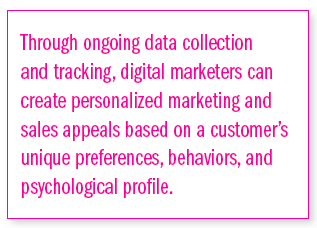 online methods–including cookies and invisible data files–to track the online behaviors of individuals.20 Through a variety of new techniques, marketers use these data to create personalized marketing and sales appeals based on a customer’s unique preferences, behaviors, and psychological profile.21 Personalization creates an entirely new set of issues that were not part of the traditional advertising and marketing paradigm, requiring researchers to take into account the individualized nature of commercial transactions in the digital environment, which often involves techniques that are not transparent to the user.
online methods–including cookies and invisible data files–to track the online behaviors of individuals.20 Through a variety of new techniques, marketers use these data to create personalized marketing and sales appeals based on a customer’s unique preferences, behaviors, and psychological profile.21 Personalization creates an entirely new set of issues that were not part of the traditional advertising and marketing paradigm, requiring researchers to take into account the individualized nature of commercial transactions in the digital environment, which often involves techniques that are not transparent to the user.
Social graph. Participatory Web 2.0 platforms–particularly social networking sites such as Facebook–are further enhancing marketers’ ability both to know the nature and extent of an individual’s social relationships, and use them for highly sophisticated social media marketing campaigns. Social networking platforms have added a feature to digital marketing that is distinct and important: the ability to tap into the social graph, which is the complex web of relationships among individuals facilitated and tracked online, enabling marketers to access and in”uence both individuals and their communities in ways that were never before possible.22 Using a host of new techniques and measurement tools, social media marketers can know the breadth and depth of these online social relationships, as well as how they function, understanding who in”uences whom, and how the process of in”uence works. These social media campaigns target teens at a point in their lives when they are relying less on their parents and family and more on friends. There are many aspects of these new forms of digital marketing that need to be explored, including the role of peer in”uence in brand promotion, and the intersection of online social interactions with eating behaviors.
Immersive environments. State-of-the-art animation, high-definition video, and other multimedia applications are spawning a new generation of immersive environments, including interactive games and three-dimensional virtual worlds, which marketers are using for brand promotion. Immersive environments surround and engross a person with powerful, realistic images and sounds, creating an experience of being inside the action, a mental state that is frequently accompanied by “intense focus, loss of self, distorted time sense, effortless action.”23 These environments often trigger a sense of “presence,” which is defined as “being there,” a subjective feeling as if one is actually physically in the virtual environment.24 Immersive marketing techniques are designed to create particularly intense experiences, plunging users into the center of the action through the use of avatars or “first-person-shooter” devices that induce a strong sense of subjectivity, heighten emotional arousal, and trigger unconscious processes. The growing use of augmented reality, video, and 3-D virtual environments–already migrating to mobile platforms–means that all digital media experiences will be increasingly immersive in the not-too-distant future.
Scholars will need to take these six unique concepts into account when designing studies of how young people are responding to digital marketing, addressing, for example, the role that ” ow, presence, and subjective experience might play in making young people susceptible to food and beverage promotions. An important challenge for research on digital marketing campaigns will be understanding how the components interact in a unified framework with one another and with traditional media marketing.
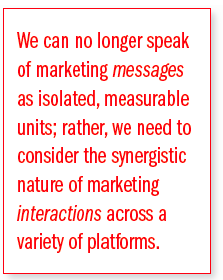 Implications for young people’s health
Implications for young people’s health
Food marketing is an important part of the environment contributing to young peoples’ health behaviors.25 Eating behaviors are highly complex, resulting from the interplay of multiple factors that impact health and nutrition, as well as the connections between people and their social, physical, and macro-level environments.26 Thus, we need to consider how digital marketing intersects with other factors–social, psychological, and biological–that play a role in food consumption by children and youth. While marketing is generally regarded as part of the macro-level environment, digital media cut across all three of these environmental domains. Because the digital marketing and media system has become such an integral part of young people’s lives, it encompasses their social environments, and in many ways aspects of their physical environments, especially through location targeting on mobile devices. Unlike television, where children’s exposure to commercials is limited to relatively brief intervals during the times when they are viewing programs, the ubiquity of the digital media culture enables marketers to reach and engage young people across multiple contexts. Marketing is now woven into the very fabric of young people’s daily experiences, integrated not only into their media content, but also into their social and personal relationships. Thus, we can no longer speak of marketing messages as isolated, measurable units; rather, we need to consider the synergistic nature of marketing interactions across a variety of platforms. Nor is marketing confined to a particular time and place; for example, it can be seeded through the social graph and then distributed widely, reinforced, and multiplied through a viral process that has no bounds. Exposure to marketing may be less important than the nature and degree of engagement with marketing and brands. In some cases, young people are actively participating in the development of the product, the design of the package, and the creation and distribution of the marketing. Personalization means that each individual has his or her own unique interactions and relationships with brands and the companies that produce and promote them. The increasingly immersive nature of all digital media means that young people are not just viewing content, but inhabiting media environments where entertainment, communication, and marketing are combined in a seamless stream of compelling sounds and images.
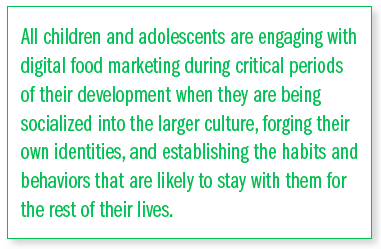 The impact of marketing is further enhanced and intensified by new forms of monitoring and measurement that were not possible before the advent of digital media. Measurement has been fully integrated into content, delivery systems, and user interactions. Through web analytics, conversation targeting, and other forms of surveillance, marketers can now track individuals online, across media, and in the real world, monitoring their interactions, social relationships, and locations. Increasingly, these various forms of analysis can take place in real time, following users’ movements and behaviors from moment to moment, and assessing their reactions to marketing techniques. As a result, different marketing approaches can be tested, refined, and tailored for maximum effect.
The impact of marketing is further enhanced and intensified by new forms of monitoring and measurement that were not possible before the advent of digital media. Measurement has been fully integrated into content, delivery systems, and user interactions. Through web analytics, conversation targeting, and other forms of surveillance, marketers can now track individuals online, across media, and in the real world, monitoring their interactions, social relationships, and locations. Increasingly, these various forms of analysis can take place in real time, following users’ movements and behaviors from moment to moment, and assessing their reactions to marketing techniques. As a result, different marketing approaches can be tested, refined, and tailored for maximum effect.
Research evidence has already established that television commercials are an important contributing factor in youth consumption of unhealthful food.27 The combination of strategies and techniques that snack food, soft drink, and fast food companies are using to reach and engage youth through digital marketing is potentially a great deal more powerful. Furthermore, while sugar, fats, and salt are particularly appealing to humans, these taste preferences may disproportionately affect African-Americans and Hispanics.28 Food marketing encountered by African-American and Hispanic youth tends to promote less healthful foods, and is less likely to support positive nutrition.29 Because digital media play such a powerful and influential role in the lives of these young people, digital food marketing targeted at ethnic minority groups may further amplify these effects. All children and adolescents are engaging with digital food marketing during critical periods of their development when they are being socialized into the larger culture, forging their own identities, and establishing the habits and behaviors that are likely to stay with them for the rest of their lives. Social norms, attitudes about food, and consumption patterns, may become routine, automatic, and in many ways, unconscious.
Rethinking the research paradigm
With the increasing concern about childhood and adolescent obesity, a few scholars have begun to turn their attention to food marketing in digital media. However, for the most part, these studies have been somewhat narrow in scope, focusing on those aspects of digital marketing (particularly food-company-sponsored advergames) that can be easily quantified and measured through content analysis and other traditional mass communication methods.30 These studies have also relied primarily on the cognitive theoretical model that has dominated both research and public policy on children and advertising for the last several decades.31 Drawing from Piaget’s theories of child development, three successive developmental stages have been identified during which children acquire increased abilities to understand advertisers’ intentions to persuade them. It is not until children reach the age of 7 or 8 that they have the cognitive ability to recognize the persuasive intent behind a television advertisement.32 By age 12, children are able to articulate a more critical comprehension of advertising intent and become more skeptical.33 According to this age-based, “cognitive defense” approach, regulatory safeguards are necessary only for the younger segment of the youth population.34
In recent years, however, some scholars have begun to critique the cognitive model, suggesting other theoretical approaches for assessing the impact of contemporary marketing.35 While no one theory can fully explain the complex ways in which contemporary food marketing influences the health behaviors of children and adolescents, we see several theoretical models and approaches that may be useful building blocks for helping scholars develop an understanding of how digital marketing works. Below, we briefly consider three: dual-process models of persuasion; models of affective response; and models of familiarity and social norms.
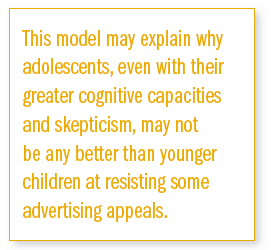 Dual-process models of persuasion. Dual-process models of persuasion are commonly utilized in consumer behavior research to understand how advertising and other marketing efforts influence consumption-related behaviors. Two separate and distinct sets of mental processes–explicit and implicit–are at work in persuasive communication. Explicit processes are consciously accessible, while implicit processes “are activated automatically and effortlessly, without intention or awareness, and are thus difficult to control.”36 This model may explain why adolescents, even with their greater cognitive capacities and skepticism, may not be any better than younger children at resisting some advertising appeals. Digital marketing routinely relies on implicit persuasion. For example, if brands are “embedded” into an entertainment context, as with product placement in movies and television or in-game advertising, they can still be influential without being consciously recognized or recalled.37 Similarly, the “elaboration likelihood” and the “heuristic systematic” models posit that attitude change can take place either through active and conscious processing of advertising messages (referred to as the “central route”) or through the “peripheral” or “heuristic” route, which can include a number of elements in an advertisement that are unrelated to the product or its benefits.38 Digital marketing incorporates many features that could be pathways in this “peripheral route,” and thus infuence young consumers’ responses. Recent research has suggested that dual-process models of persuasion may be a more appropriate approach for understanding new media marketing strategies.39
Dual-process models of persuasion. Dual-process models of persuasion are commonly utilized in consumer behavior research to understand how advertising and other marketing efforts influence consumption-related behaviors. Two separate and distinct sets of mental processes–explicit and implicit–are at work in persuasive communication. Explicit processes are consciously accessible, while implicit processes “are activated automatically and effortlessly, without intention or awareness, and are thus difficult to control.”36 This model may explain why adolescents, even with their greater cognitive capacities and skepticism, may not be any better than younger children at resisting some advertising appeals. Digital marketing routinely relies on implicit persuasion. For example, if brands are “embedded” into an entertainment context, as with product placement in movies and television or in-game advertising, they can still be influential without being consciously recognized or recalled.37 Similarly, the “elaboration likelihood” and the “heuristic systematic” models posit that attitude change can take place either through active and conscious processing of advertising messages (referred to as the “central route”) or through the “peripheral” or “heuristic” route, which can include a number of elements in an advertisement that are unrelated to the product or its benefits.38 Digital marketing incorporates many features that could be pathways in this “peripheral route,” and thus infuence young consumers’ responses. Recent research has suggested that dual-process models of persuasion may be a more appropriate approach for understanding new media marketing strategies.39
Models of affective response. Brand marketing, even outside the digital context, is increasingly focused on instilling more emotional responses rather than conscious, deliberate ones. But with digital marketing, there are additional elements that are purposely designed to circumvent the deliberate elaboration or conscious processing of product attributes. The role of affect in persuasion has generally been construed as a mediator in dual-process models. That is, the role of emotions has been studied in terms of the in”uence of emotional appeals on people’s use of the central route relative to the peripheral route. A number of scholars have proposed that unconscious, or automatic, processes may underlie responses to emotionally oriented advertising.40 This may be 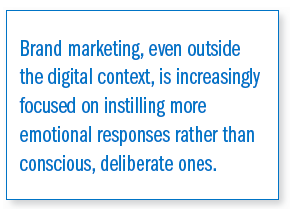 particularly important with children and adolescents.41 The Advertising Research Foundation’s initiative on engagement, as well as many other contemporary research and marketing practices in the digital arena, are purposely designed to circumvent the deliberate elaboration or conscious processing of product attributes and to elicit emotional responses.
particularly important with children and adolescents.41 The Advertising Research Foundation’s initiative on engagement, as well as many other contemporary research and marketing practices in the digital arena, are purposely designed to circumvent the deliberate elaboration or conscious processing of product attributes and to elicit emotional responses.
Models of familiarity and social norms. Given the ubiquity of digital media, exposure to marketing has become frequent and commonplace, engendering a level of familiarity that may go unnoticed yet result in significant marketing effects. According to the mere exposure effect model (also called the familiarity principle in social psychology), people exhibit a preference for things because they are familiar with them.42 Young people are likely to develop positive associations with logos they encounter in various forms throughout their daily experiences.43 If merely being exposed to a logo repeatedly and in different contexts can produce enhanced positive attitudes, what might be the impact of such practices as appropriating brand logos as part of one’s social network profile, or developing a video to demonstrate one’s loyalty to the brand and then distributing it among friends? Some evidence already points to such effects in a digital context.44 This category of theories also highlights the importance of understanding norms related to digital marketing. Scholars have noted that unhealthful eating behaviors may emerge and flourish in environments where that behavior is viewed as normal and acceptable.45 Repeated exposure to marketing stimuli–especially stimuli that are processed less consciously–may lead to perceived norms regarding specific foods and beverages. When the ubiquity of marketing brands and icons is combined with the various forms of engagement and integrated into social interactions, the impact of familiarity and social norms may be further intensified. It is critical for researchers to understand the effect of synergy across digital platforms, as well as digital synergy with other (traditional) marketing methods. Contextual factors must also be taken into account, especially when researching ethnic minority youth and other cultural subgroups.46
Although we have highlighted some relevant theories and models, additional approaches need to be explored that could provide further insights for guiding the study of digital food marketing. For example, the obesity research paradigm developed by the African American Collaborative Obesity Research Network (AACORN) is framed as an ecological model that includes variables specifically focused on studying African-American communities and may be adapted to examine other sub-cultural groups.47 It is also important to consider the theories that digital marketers cite as influential in developing their strategies.48 For example, social media marketers have drawn from social network theory to design their techniques for influencing consumers through online social networking platforms.49 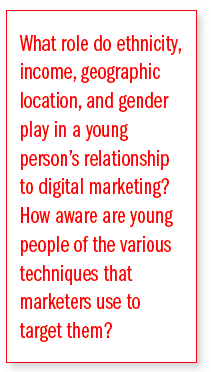 A number of broader questions need to be at the core of any research agenda for understanding digital food marketing’s impact on young people. For example: What is the role of age difference in how youth are affected by digital marketing? How does implicit persuasion work in the digital context? How does it vary depending on the marketing techniques employed? What role do ethnicity, income, geographic location, and gender play in a young person’s relationship to digital marketing? How aware are young people of the various techniques that marketers use to target them? To what extent and in what ways are they aware of the risks involved with certain forms of digital food marketing? How does digital marketing increase desire, not only for specific food and beverage brands, but also for unhealthful products in general? As scholars begin to address some of these questions, we suggest several areas of inquiry that deserve particular focus:
A number of broader questions need to be at the core of any research agenda for understanding digital food marketing’s impact on young people. For example: What is the role of age difference in how youth are affected by digital marketing? How does implicit persuasion work in the digital context? How does it vary depending on the marketing techniques employed? What role do ethnicity, income, geographic location, and gender play in a young person’s relationship to digital marketing? How aware are young people of the various techniques that marketers use to target them? To what extent and in what ways are they aware of the risks involved with certain forms of digital food marketing? How does digital marketing increase desire, not only for specific food and beverage brands, but also for unhealthful products in general? As scholars begin to address some of these questions, we suggest several areas of inquiry that deserve particular focus:
Adolescent vulnerabilities. Adolescents are at serious risk for obesity, and the teen years are a critical developmental period, during which long-term consumer habits and eating behaviors are established and reinforced.50 Yet, this age group has not received the same level of scholarly attention that has been focused on younger children, particularly with regard to food marketing.51 Because of the emphasis on cognitive theory in much of the advertising effects research, scholars have viewed adolescents as more knowledgeable about marketer intentions, and thus better able to resist advertising and marketing influences.52 However, recent research suggests that biological and psychosocial attributes of the adolescent experience may play an important role in how teens respond to marketing, making them more vulnerable than they were thought to have been in the past, especially when they are distracted, are in a state of high arousal, or are subjected to peer pressure.53 These are exactly the conditions that digital marketing is often designed to induce. All of these issues need to be explored further if we are to understand fully how these processes work in digital food marketing. Some specific questions that should be addressed through empirical research are: What role does self-esteem play in contributing to a young person’s vulnerability to specific kinds of unhealthful foods, as well as specific forms of digital marketing promoting those foods? Do young people who are already overweight or obese have greater susceptibility to these forms of marketing? How do digital media increase arousal among teens? What types of media experiences (e.g., video games, online video, interactive television) are more likely to induce these states? What role does mood play in an adolescent’s vulnerability to digital marketing? How do digital media trigger mood variation?
Identity. The role of identity formation in the commercial digital context is an important related area for further research. Consumer researchers have begun to examine how marketing contributes to “self-brand connections” among children and adolescents, with very
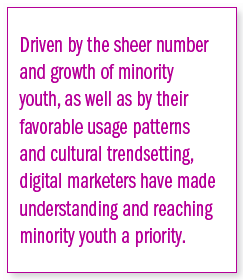 little attention to the role of digital marketing in this process.54 Many digital marketing strategies (particularly social media campaigns) purposely seek to exploit this nexus of self-identity and brand identity. But we still know very little about how these interrelationships in”uence young people. For example, how are brands that one has appropriated as part of one’s identity used to express that self to others? The intersections of brand identity and personal identity may be particularly in”uential with ethnic minority youth, who share general youth challenges such as developing a personal identity and fitting in with peers, yet are also confronted with the added task of developing an ethnic identity, which is important to their self-esteem.55 More generally, ethnic-targeted marketing may serve identity development purposes among minority youth, and this relationship may support enhanced responsiveness to digital target marketing. Understanding the processes and mechanisms that underlie the relationship appears to be a fruitful area for future research. For example, does digital marketing intensify the impact of food and beverage brands on teens’ identities? And if so, how? And while this is an important area of inquiry for all children, investigations should also consider additional or different influences that emerge specifically for minority youth. For example, are there specific identity-relevant targeted strategies that enhance receptiveness among minority youth?
little attention to the role of digital marketing in this process.54 Many digital marketing strategies (particularly social media campaigns) purposely seek to exploit this nexus of self-identity and brand identity. But we still know very little about how these interrelationships in”uence young people. For example, how are brands that one has appropriated as part of one’s identity used to express that self to others? The intersections of brand identity and personal identity may be particularly in”uential with ethnic minority youth, who share general youth challenges such as developing a personal identity and fitting in with peers, yet are also confronted with the added task of developing an ethnic identity, which is important to their self-esteem.55 More generally, ethnic-targeted marketing may serve identity development purposes among minority youth, and this relationship may support enhanced responsiveness to digital target marketing. Understanding the processes and mechanisms that underlie the relationship appears to be a fruitful area for future research. For example, does digital marketing intensify the impact of food and beverage brands on teens’ identities? And if so, how? And while this is an important area of inquiry for all children, investigations should also consider additional or different influences that emerge specifically for minority youth. For example, are there specific identity-relevant targeted strategies that enhance receptiveness among minority youth?
Targeted digital marketing to ethnic minority groups. Driven by the sheer number and growth of minority youth, as well as by their favorable usage patterns and cultural trendsetting, digital marketers have made understanding and reaching minority youth a priority. Target marketing to African-American and Hispanic youth influences their consumption choices by affecting the awareness and availability of food-related information and options, and can contribute to perceived norms.56 Further, research suggests that ethnic minority youth are more interested in, positive towards, and influenced by marketing than non-Hispanic whites. Moreover, minority youth are important cultural models who influence the behaviors of the larger youth population.57 As a consequence, minority youth may be subject to multiple layers of vulnerability, given family circumstances, normative exposures to obesity, and the contexts in which they live.58 Unfortunately, however, there is very limited research on ethnic minority youth and marketing, especially of direct relevance to digital.59 In the face of such aggressive market research and digital promotion of unhealthful foods to African-American and Hispanic young people, research is urgently needed to address a number of key questions, including: What are the specific issues with regard to vulnerability and receptivity of digital marketing efforts among youth of color? When considering lower income youth of color, are there particular effects of digital marketing that depend on the settings and circumstances of the youths’ lives? Does geolocation targeting through mobile phones and other devices take particular advantage of those youth who are already more disadvantaged than others, such as those who live in unhealthy contexts?
Impulsivity and addictive behaviors. So-called “rewarding foods,” those that are high in sugar, fat, and salt, “are altering the biological circuitry of our brains,” as David Kessler explains in his book, The End of Overeating. “Sugar and fat are reinforcing, and cues, quantity, concentration, and variety all increase that reinforcement value.”60 Food and beverage manufacturers continually research and perfect these combinations of “flavors and tastes in order to maximize their appeal to consumers.61 Cues may include  emotional memories of a particular kind of food, or other kinds of positive associations. Over time, such responses become habitual.62 These ingredients, as well as other food additives, may also trigger an addictive process in the brain in ways that are similar to how drugs of abuse work.63 So far, researchers have not examined the role of digital media and marketing in any of these processes, which is an area that deserves focused attention. When products with compelling and addictive properties are marketed to young people through contemporary digital techniques, their impact on health behaviors may be compounded. For example, snack foods with high fats, sugars, and salts are often inserted seamlessly into immersive virtual environments and interactive games.64 These environments are already known to induce a “”ow” experience in users, where cognitive responses are less likely to be elicited. Might they also act as contextual cues that trigger food cravings? To the extent that these experiences are habitual, as they often are with interactive games and virtual worlds, could their impact be further intensified through repeated interactions?
emotional memories of a particular kind of food, or other kinds of positive associations. Over time, such responses become habitual.62 These ingredients, as well as other food additives, may also trigger an addictive process in the brain in ways that are similar to how drugs of abuse work.63 So far, researchers have not examined the role of digital media and marketing in any of these processes, which is an area that deserves focused attention. When products with compelling and addictive properties are marketed to young people through contemporary digital techniques, their impact on health behaviors may be compounded. For example, snack foods with high fats, sugars, and salts are often inserted seamlessly into immersive virtual environments and interactive games.64 These environments are already known to induce a “”ow” experience in users, where cognitive responses are less likely to be elicited. Might they also act as contextual cues that trigger food cravings? To the extent that these experiences are habitual, as they often are with interactive games and virtual worlds, could their impact be further intensified through repeated interactions?
Similarly, could cravings be triggered through mobile marketing by targeting young people with fast-food promotions and discount coupons when they are near a fast food restaurant? These types of campaigns could create powerful contexts in which resistance to marketing messages would be particularly challenging. Studies are needed to explore these and other related hypotheses.
Methods for studying digital media and marketing
Flexible and innovative approaches are needed to understand the complex ways that youth are interacting with this new commercial media culture. Much of this research will need to be collaborative and interdisciplinary, combining expertise from various fields to pose hypotheses that cut across disciplines and across levels of influence.
65 For example, the research methods that academic scholars are employing to study youth engagement with digital media culture–including qualitative, ethnographic investigations of youth subcultures–provide models for exploring digital marketing.66 Many researchers across academic fields, as well as within industry, are adapting ethnographic techniques to study behavior online, dubbed 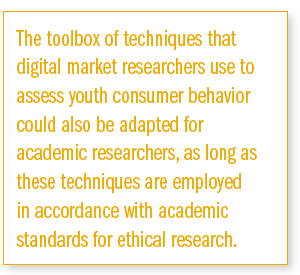 netnography, to understand how multicultural youth use and are influenced by social networks and other digital media.67 Studies undertaken on youth and digital marketing must also be grounded in the real-world practices of the contemporary marketplace, which is not static but constantly evolving. This will require close, ongoing monitoring of market research, theories, platforms, and techniques. The plethora of new metrics are a clear departure from more traditional types of measurement, and need to be fully understood in order to design research methods that academics can use for testing the health impacts of food and beverage marketing in the digital media. The toolbox of techniques that digital market researchers use to assess youth consumer behavior could also be adapted for academic researchers, as long as these techniques are employed in accordance with academic standards for ethical research. Specific measures could be developed for assessing each of the key concepts; these measures, in turn, could be incorporated into a model for understanding the impact of food marketing on attitudes and behaviors.68
netnography, to understand how multicultural youth use and are influenced by social networks and other digital media.67 Studies undertaken on youth and digital marketing must also be grounded in the real-world practices of the contemporary marketplace, which is not static but constantly evolving. This will require close, ongoing monitoring of market research, theories, platforms, and techniques. The plethora of new metrics are a clear departure from more traditional types of measurement, and need to be fully understood in order to design research methods that academics can use for testing the health impacts of food and beverage marketing in the digital media. The toolbox of techniques that digital market researchers use to assess youth consumer behavior could also be adapted for academic researchers, as long as these techniques are employed in accordance with academic standards for ethical research. Specific measures could be developed for assessing each of the key concepts; these measures, in turn, could be incorporated into a model for understanding the impact of food marketing on attitudes and behaviors.68
Research to inform policy
Studies that can apply what social scientists are learning to critical issues in the legal and policy arenas are also urgently needed. Though the government has limited ability to ban advertising and marketing content because of important constitutional protections for free speech, there are several areas where it can develop safeguards that may limit what marketers can do, especially in areas of particular sensitivity.69 For example, practices that undermine rational decision-making in the marketplace and tap into the unconscious/subconscious processes may be inherently deceptive or unfair.70 These may include augmented reality, immersive environments, and similar techniques. Other practices that warrant close attention are: integration of marketing and “content” to make the two indistinguishable; linking point of influence to point of purchase (for example, in mobile marketing campaigns); peer-to-peer strategies employed in the social graph, especially on social network platforms; prizes, contests, and other incentives designed to encourage participation in marketing strategies and to facilitate data collection; behavioral targeting, smart ads, and dynamic product placement; and the use of neuromarketing to develop implicit persuasion techniques aimed at underage youth.71
Addressing these new marketing practices may require new legal theories and regulatory approac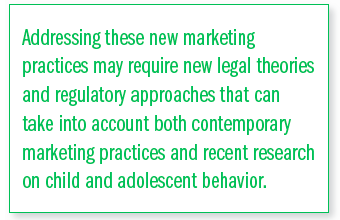 hes that can take into account both contemporary marketing practices and recent research on child and adolescent behavior. For example, should the panoply of techniques used to target young people online–behavioral targeting, social media surveillance, and the like–be subject to greater government scrutiny than traditional advertising “messages”? Should marketing that is designed to bypass rational decision making be considered differently from protected commercial speech? There is an urgent need to revisit the cognitive defense model that has provided the theoretical underpinning for much of children’s advertising policy and self-regulation since the 1970s.72 The model seems particularly out of date in light of the strategies used by today’s digital marketers. Finally, the growing public debate over online privacy requires researchers to address the policy issues related to data collection and behavioral targeting, which have become a central strategy in digital food-and-beverage promotion efforts.
hes that can take into account both contemporary marketing practices and recent research on child and adolescent behavior. For example, should the panoply of techniques used to target young people online–behavioral targeting, social media surveillance, and the like–be subject to greater government scrutiny than traditional advertising “messages”? Should marketing that is designed to bypass rational decision making be considered differently from protected commercial speech? There is an urgent need to revisit the cognitive defense model that has provided the theoretical underpinning for much of children’s advertising policy and self-regulation since the 1970s.72 The model seems particularly out of date in light of the strategies used by today’s digital marketers. Finally, the growing public debate over online privacy requires researchers to address the policy issues related to data collection and behavioral targeting, which have become a central strategy in digital food-and-beverage promotion efforts.
Conclusion: Researchers must expand their investigations to accommodate the new framework for digital food marketing
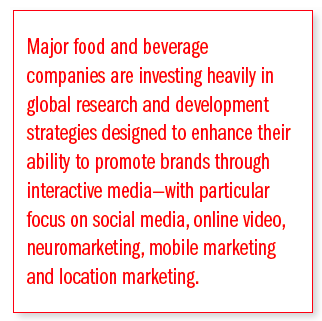 Digital marketing is advancing rapidly, and is poised to reach a crucial tipping point in the very near future, as expenditures for Internet and mobile advertising continue to rise. Major food and beverage companies are investing heavily in global research and development strategies designed to enhance their ability to promote brands through interactive media–with particular focus on socialmedia, online video, neuromarketing, mobile marketing, and location marketing.73 Facebook’s recent $50 billion valuation reflects its new role as a “must-have” ad buy for marketers targeting youth.74 Google and other leading digital advertising companies are working with market research firms to document what they say is growing evidence that online ads lead to increased store sales.75 New techniques for data collection, monitoring, profiling, and targeting are being rolled out almost daily, along with sophisticated cross-platform measurement tools that can assess and fine-tune the impact of digital campaigns with greater and greater precision. To date, academic researchers concerned about the impact of food marketing on children and adolescents have been unable to stay abreast of these developments, or to understand fully the nature and scope of their impact on young people’s behaviors. A coordinated and strategic effort is urgently needed to address the dramatic changes in the advertising and marketing landscape, and to develop public health interventions and regulatory safeguards for reversing the youth obesity epidemic.
Digital marketing is advancing rapidly, and is poised to reach a crucial tipping point in the very near future, as expenditures for Internet and mobile advertising continue to rise. Major food and beverage companies are investing heavily in global research and development strategies designed to enhance their ability to promote brands through interactive media–with particular focus on socialmedia, online video, neuromarketing, mobile marketing, and location marketing.73 Facebook’s recent $50 billion valuation reflects its new role as a “must-have” ad buy for marketers targeting youth.74 Google and other leading digital advertising companies are working with market research firms to document what they say is growing evidence that online ads lead to increased store sales.75 New techniques for data collection, monitoring, profiling, and targeting are being rolled out almost daily, along with sophisticated cross-platform measurement tools that can assess and fine-tune the impact of digital campaigns with greater and greater precision. To date, academic researchers concerned about the impact of food marketing on children and adolescents have been unable to stay abreast of these developments, or to understand fully the nature and scope of their impact on young people’s behaviors. A coordinated and strategic effort is urgently needed to address the dramatic changes in the advertising and marketing landscape, and to develop public health interventions and regulatory safeguards for reversing the youth obesity epidemic.
Authors: Kathryn Montgomery, PhD, School of Communication, American University; Sonya Grier, PhD Kogod School of Business, American University; Jeff Chester, MSW Center for Digital Democracy; Lori Dorfman, DrPH Berkeley Media Studies Group, Public Health Institute.
This research was supported by a grant from the Robert Wood Johnson Foundation’s Healthy Eating Research program (grant #65063).
The authors thank the researchers whose work they studied and discussed over the course of the project, especially those who participated in two meetings we convened on digital marketing: one in April 2009 co-sponsored with the National Policy and Legal Analysis Network to Prevent Childhood Obesity (NPLAN), and the second co-sponsored with the Eunice Kennedy Shriver National Institute for Child Health and Human Development (NICHD).
Graphic design by Barbara Moulton.
References
1. See, for example, Advertising Research Foundation, “NeuroStandards Collaboration,” http://www.hearf.org/assets/neurostandards-collaboration (viewed 26 Feb. 2011). Microsoft Advertising and Carat presented research involving Quick Service Restaurants (QSRs) and the influence of the Internet. “Digital is Core to the Journey: Mobile is Especially influential,” they explained. Microsoft Advertising and Carat, “The New Shopper: Today’s Purchase Path and the Media that Influences It,” n.d., http://advertising.microsoft.com/wwdocs/user/en-us/researchlibrary/researchreport/USOnline-Consumer-Retail-Research-Carat-Microsoft- Advertising.pdf (viewed 24 Feb. 2011). See also Jeff Chester and Kathryn Montgomery, “Interactive Food & Beverage Marketing: Targeting Children and Youth in the Digital Age,” May 2007, http://www.digitalads. org/documents/digiMarketingFull.pdf(viewed 25 Feb. 2011).
2. While online advertising spending still constitutes a relatively small portion of overall U.S. advertising expenditures (approximately $27 billion for online in 2010 as compared to $173 billion overall), the numbers are growing steadily. Mike Sachoff, “Online Ad Spending To Outpace Print In 2010,” WebProNews, 8 Mar. 2011, http://www. webpronews.com/topnews/2010/03/08/onlinead- spending-to-outpace-print-in-2010 (viewed 26 Feb. 2011). Last year, according to comScore, “U.S. Internet users received a total of 4.9 trillion display ads,” an increase of more than 23 percent from the previous year “Total U.S. e-commerce spending reached $227.6 billion in 2010, up 9 percent versus the previous year.” comScore, “comScore Releases ‘The 2010 U.S. Digital Year in Review’: Report Highlights 2010 Digital Marketing Trends and Implications for 2011,” 8 Feb. 2011, http://www.comscore.com/Press_Events/ Press_Releases/2011/2/comScore_Releases_ The_2010_U.S._Digital_Year_in_Review(viewed 26 Feb. 2011).
3. “Explore Ad Age’s Databases,” Advertising Age, http://adage.com/datacenter/(registration required).
4. For example, Mars’ M&M’s has used the Alcance Media Group advertising network, which “consists of hundreds of websites both U.S. and international that reach the Hispanic market.” Alcance Media Group, “Advertiser Solutions,” http://www. alcancemg.com/advertisers/solutions/advertisersolutions/ (viewed 20 Aug. 2010). Burger King franchises in key markets, similarly, used BK’s “Futbol Kingdom” campaign to drive “incredible results,” according to its Hispanic agency Macias Advertising, Facebook, http://www.facebook. com/group.php?gid=44583321445 (viewed 20 Aug. 2010). McDonald’s is placing an even greater emphasis on generating new revenues through targeting multicultural consumers. It is now one of the “ve top companies marketing to Hispanics, spending $100 million a year, according to Advertising Age. McDonald’s has made a major effort to become “the country’s leading partner with the Hispanic community,” including in areas related to “education, marketing, vendors/suppliers and employment.” The company claims to have “one of the highest percentages of Hispanics in top management positions at 12%,” and “Hispanic crews at many of the country’s 14,000 restaurants receive free English-language and other career development courses. The McDonald’s Hispanic Owner/ Operators Association (MHOA) is the country’s largest organization of Hispanic franchisees with 269 members who operate 900 restaurants in 35 states with revenues of almost $2 billion. In addition, McDonald’s utilizes more Hispanic suppliers than any other corporation.” Hispanic Public Relations Society of America, “Premio Awards: Corporation of the Year: McDonald’s Corporation,” 2009, http://www.hpra-usa.org/awards.html (viewed 20 Aug. 2010).
5. Alan J. Bush, Rachel Smith, and Craig Martin, “The Influence of Consumer Socialization Variables on Attitude toward Advertising: A Comparison of African- Americans and Caucasians,” Journal of Advertising 28, n. 3 (1999): 13-24; Felipe Korzenny, Betty Ann Korzenny, Holly McGavock, and Maria Gracia Inglessis, “The Multicultural Marketing Equation: Media, Attitudes, Brands, and Spending,” Center for Hispanic Marketing Communication, Florida State University, 2006; George P. Moschis, Consumer Socialization: A Life-Cycle Perspective (Lexington, MA: Lexington Books, 1987); Nitish Singh, Ik-Whan Kwon, and Arun Pereira, “Cross-Cultural Consumer Socialization: An Exploratory Study of Socialization Influences across Three Ethnic Groups,” Psychology & Marketing 20, n. 10 (2003): 15; Carolyn A. Stroman, “Television’s Role in the Socialization of African American Children and Adolescents,” The Journal of Negro Education 60, n. 3 (1991): 314- 327; Gail Baker Woods, Advertising and Marketing to the New Majority (Belmont, CA: Wadsworth Publishing Company, 1995).
6. U.S. Census, “An Older and More Diverse Nation by Midcentury,” 14 Aug. 2008, http://www.census.gov/ newsroom/releases/archives/population/cb08- 123.html (viewed 12 May 2009).
7. J. M. McGinnis, J. A. Gootman, and V. I. Kraak, eds., Food Marketing to Children and Youth: Threat or Opportunity? (Washington, DC: Institute of Medicine, 2005).
8. E. S. Moore and V. J. Rideout, “The Online Marketing of Food to Children: Is it Just Fun and Games?” Journal of Public Policy & Marketing 6, n. 2 (2007): 202-220; E. S. Moore, “It’s Child’s Play: Advergaming and the Online Marketing of Food to Children,” 2006, http://www.kff.org/entmedia/upload/7536. pdf (viewed 2 Oct. 2008); M. Story and S. French, “Food Advertising and Marketing Directed at Children and Adolescents in the U.S.,” International Journal of Behavioral Nutrition and Physical Activity 1 (2004): 1-3.; E. T. Quilliam, N. M. Rifon, M. Lee, H-J. Paek, and R. Cole, “Food Advergames Targeting Children: Prevalence, Effects, and Policy Implications,” paper presented to the conference, Consumer Culture and the Ethical Treatment of Children: Theory, Research & Fair Practice, East Lansing, 2009; L. M. Alvy and S. L. Calvert, “Food Marketing on Popular Children’s Web Sites: A Content Analysis,” Journal of the American Dietary Association 108, n. 4 (2008): 710-713; S. L. Calvert, A. B. Jordan, R. R. Cocking, eds., Children in the Digital Age: Influences of Electronic Media on Development (Westport, CT: Praeger, 2002): 57-70; S. L. Calvert, “Children as Consumers: Advertising and Marketing,” The Future of Children 18, n. 1 (2008): 205-234; D. Kunkel, B. L. Wilcox, J. Cantor, et al., “Report of the APA Task Force on Advertising and Children,” 20 Feb. 2004, http://www.apa.org/ releases/childrenads.pdf; Kaiser Family Foundation, “The Role of Media in Childhood Obesity,” Feb. 2004, http://www.kff.org/entmedia/upload/The-Role- Of-Media-in-Childhood-Obesity.pdf (viewed 2 Oct. 2008); American Academy of Pediatrics Committee on Communications, “Policy Statement: Children, Adolescents, and Advertising,” Pediatrics 118, n. 6 (Dec. 2006): 2563-2569, http://pediatrics. aappublications.org/cgi/content/full/118/6/2563 (viewed 4 Oct. 2008); P. M. Valkenburg, “Media and Youth Consumerism,” Journal of Adolescent Health 27 (S 2000): 52-56; Jennifer L. Harris, Marlene B. Schwartz, Kelly D. Brownell, et al., “Cereal FACTS: Evaluating the Nutrition Quality and Marketing of Children’s Cereals,” Oct. 2009, http://www.cerealfacts.org/media/Cereal_FACTS_Report.pdf (viewed 10 Apr. 2010); E. O. Lingas, L. Dorfman, and E. Bukofzer, “Nutrition Content of Food and Beverage Products on Web Sites Popular with Children,” American Journal of Public Health 99 (2009):S587-S592; Jennifer L. Harris, Marlene B. Schwartz, Kelly D. Brownell, et al., “Fast Food FACTS: Evaluating Fast Food Nutrition and Marketing to Youth,” Yale Rudd Center for Food Policy and Obesity, Nov. 2010, http://www.fastfoodmarketing.org/ media/FastFoodFACTS_Report.pdf (viewed 21 Mar. 2001).
9. For example, the six-volume series from the MacArthur Foundation initiative on Digital Media and Learning, published by MIT Press, has no titles dedicated to marketing, and the issue is covered in only a few of the research papers. The John D. and Catherine T. MacArthur Foundation Series on Digital Media and Learning, MIT Press, http://mitpress.mit.edu/catalog/browse/browse. asp?btype=6&serid=170; “Building the Field of Digital Media and Learning,” http://digitallearning.macfound.org/site/c.enJLKQNlFiG/b.2029199/ k.94AC/Latest_News.htm (both viewed 25 Mar 2009). Similarly, ethnographic scholars have been conducting research on how youth are using social networking platforms, but without consideration of marketing effects. See, for example, danah boyd and Nicole Ellison, “Social Network Sites: De”nition, History, and Scholarship,” Journal of Computer-Mediated Communication 13, n. 1 (Oct. 2007): 210-230; danah boyd, “Why Youth (Heart) Social Network Sites: The Role of Networked Publics in Teenage Social Life,” in David Buckingham, ed., Youth, Identity, and Digital Media, MacArthur Foundation Series on Digital Learning (Cambridge, MA: MIT Press, 2007): 119-142, http://www. mitpressjournals.org/doi/pdf/10.1162/ dmal.9780262524834.119 (viewed 9 Apr. 2010).
10. Chester and Montgomery, “Interactive Food & Beverage Marketing: Targeting Children and Youth in the Digital Age”; S. A. Grier and S. K. Kumanyika, “The Context for Choice: Health Implications of Targeted Food and Beverage Marketing to African Americans,” American Journal of Public Health 98, n. 9 (2008): 1616-29. See also, for example, the research presentations given to the Advertising Research Foundation’s Youth Council, http://www. thearf.org/assets/youth-council?fbid=yqcPGDy_ HEW (viewed 10 Apr. 2010).
11. Mira Lee, Yoonhyeung Choi, Elizabeth Quilliam, and Richard T. Cole, “Playing with Food: Content Analysis of Food Advergames,” The Journal of Consumer Affairs 43, n. 1 (2009): 129-154; Moore and Rideout, “The Online Marketing of Food to Children: Is it Just Fun and Games?”; Fareena Sultan, Andrew J. Rohm, and Tao (Tony) Gao, “Factor Influencing Consumer Acceptance of Mobile Marketing: A Two-Country Study of Youth Markets,” Journal of Interactive Marketing 23, n. 4 (2009): 308-320.
12. McGinnis, Gootman & Kraak, eds., Food Marketing to Children and Youth: Threat or Opportunity?; D. Kunkel, B. L. Wilcox, J. Cantor, et al., “Report of the APA Task Force on Advertising and Children,” 20 Feb. 2004, http://www.apa.org/releases/childrenads. pdf. (viewed 9 Apr. 2010).
13. We have arrived at these concepts through a process of inductive analysis, drawing from several broad areas of research, including: 1) marketing and market research industry literature on new media, children, and youth; 2) academic studies–both quantitative and qualitative–on new media use by children and youth; and 3) analysis of the practices and techniques used by marketers to target youth, including, but not limited to, companies promoting food and beverage. The authors wish to thank the Robert Wood Johnson Foundation and the Healthy Eating Research Initiative for their support of this research. This paper is based on a longer report completed under the HER grant #65063.
14. Victoria J. Rideout, Ulla G. Foehr, and Donald F. Roberts, “Generation M2: Media in the Lives of 8-18-Year-Olds,” Kaiser Family Foundation Study, Jan. 2010, http://www.kff.org/entmedia/upload/8010.pdf (viewed 14 Sept. 2010).
15. Yochai Benkler, The Wealth of Networks: How Social Production Transforms Markets and Freedom (New Haven, Connecticut: Yale University Press, 2006): 272.
16.. Yahoo! and OMD, “Truly, Madly, Deeply Engaged: Global Youth, Media and Technology,” 2005, http:// www.iabaustralia.com.au/Truly_Madly_Final_ booklet.pdf (viewed 27 Mar. 2007).
17. See A.K. Pradeep, The Buying Brain: Secrets for Selling to the Subconscious Mind (New York: Wiley, 2010).
18. Ward Hanson, Principles of Internet Marketing (Cincinnati, OH: South Western College Publishing, 1999).
19. David Hallerman, “Behavioral Targeting: Marketing Trends,” eMarketer, 2008; I. Khan, B. Weishaar, L. Polinsky, et al., “Nothing but Net: 2008 Internet Investment Guide,” 2008, https://mm.jpmorgan. com/stp/t/c.do?i=2082C-248&u=a_p*d_170762. pdf*h_-3ohpnmv (viewed 23 Mar. 2009).
20. Center for Digital Democracy and U.S. PIRG, “Complaint and Request for Inquiry and Injunctive Relief Concerning Unfair and Deceptive Online Marketing Practices. Federal Trade Commission Filing,” 1 Nov. 2006, http://www.democraticmedia. org/”les/pdf/FTCadprivacy.pdf; Center for Digital Democracy and U.S. PIRG, “Supplemental Statement In Support of Complaint and Request for Inquiry and Injunctive Relief Concerning Unfair and Deceptive Online Marketing Practices,” Federal Trade Commission Filing, 1 Nov. 2007, http://www. democraticmedia.org/”les/FTCsupplemental_ statement1107.pdf; Center for Digital Democracy and U.S. PIRG, “Complaint and Request for Inquiry and Injunctive Relief Concerning Unfair and Deceptive Mobile Marketing Practices”; EPIC, Center for Digital Democracy, and U.S. PIRG, “In the matter of Google, Inc. and DoubleClick, Inc., Complaint and Request for Injunction, Request for Investigation and for Other Relief, before the Federal Trade Commission,” 20 Apr. 2007, http://www.epic.org/ privacy/ftc/google/epic_complaint.pdf; EPIC, Center for Digital Democracy, and U.S. PIRG, “In the matter of Google, Inc. and DoubleClick, Inc., Second Filing of Supplemental Materials in Support of Pending Complaint and Request for Injunction, Request for Investigation and for Other Relief,” 17 Sept. 2007, http://epic.org/privacy/ftc/google/supp2_091707. pdf (all viewed 12 Oct. 2009).
21. Hallerman, “Behavioral Targeting: Marketing Trends”; Khan, Weishaar, Polinsky, et al., “Nothing but Net: 2008 Internet Investment Guide.”
22. A. Iskold, “Social Graph: Concepts and Issues,” ReadWriteWeb, 12 Sept. 2007, http://www. readwriteweb.com/archives/social_graph_concepts_and_issues.php (viewed 2 Oct. 2008).
23. Allen Vamey, “Immersion Unexplained,” The Escapist, 8 Aug. 2006, http://www. escapistmagazine.com/articles/view/issues/ issue_57/341-Immersion-Unexplained (viewed 26 Aug. 2010).
24. Hairong Li, Terry Daugherty, and Frank Biocca, “Impact of 3-D Advertising on Product Knowledge, Brand Attitude, and Purchase Intention: The Mediating Role of Presence,” Journal of Advertising 31, n. 3 (Fall 2002): 43.
25. Wendy L. Johnson-Askew, et al, “Decision Making in Eating Behavior: State of the Science and Recommendations for Future Research,” Annals of Behavioral Medicine 38, Suppl. (2009).
26. Mary Story, et al., “Creating Healthy Food and Eating Environments: Policy and Environmental Approaches,” Annual Review of Public Health 29 (2008): 253-272.
27. The National Academies, “Food Marketing Aimed at Kid Influences Poor Nutritional Choices, IOM Study Finds; Broad Effort Needed to Promote Healthier Products and Diets,” press release, 6 Dec. 2005, http://www8.nationalacademies.org/onpinews/ newsitem.aspx?RecordID=11514 (viewed 26 Mar. 2007); McGinnis, et al., eds., Food Marketing to Children and Youth: Threat or Opportunity?
28. Harris, Brownell, and Bargh, “The Food Marketing Defense Model: Integrating Psychological Research to Protect Youth and Inform Public Policy.”
29. Hae-Kyong Bang and Bonnie B. Reece, “Minorities in Children’s Television Commercials: New, Improved, and Stereotyped,” Journal of Consumer Affairs 37, n. 1 (2003): 42-66; Grier and Kumanyika, “The Context for Choice: Health Implications of Targeted Food and Beverage Marketing to African Americans”; Kristen Harrison, “Fast and Sweet: Nutritional Attributes of Television Food Advertisements with and without Black Characters,” Howard Journal of Communications 17, n. 4 (2006): 16; Corliss Wilson Outley and Abdissa Taddese, “A Content Analysis of Health and Physical Activity Messages Marketed to African American Children During After-School Television Programming,” Archives of Pediatrics & Adolescent Medicine 160, n. 4 (2006): 4; Lisa M. Powell, Glen Szczypka, and Frank J. Chaloupka, “Adolescent Exposure to Food Advertising on Television,” American Journal of Preventive Medicine 33, n. 4 (2007): S251-S256.
30. Moore and Rideout, “The Online Marketing of Food to Children: Is it Just Fun and Games?”; Moore, “It’s Child’s Play: Advergaming and the Online Marketing of Food to Children”; Story and French, “Food Advertising and Marketing Directed at Children and Adolescents in the U.S.”; Lee, Choi, Quilliam, and Cole, “Playing with Food: Content Analysis of Food Advergames.”
31. Alvy and Calvert, “Food Marketing on Popular Children’s Web Sites: A Content Analysis”; Calvert, Jordan, and Cocking, eds., Children in the Digital Age: Inlfuences of Electronic Media on Development; Calvert, “Children as Consumers: Advertising and Marketing”; Kunkel, Wilcox, Cantor, et al., “Report of the APA Task Force on Advertising and Children”; Kaiser Family Foundation, “The Role of Media in Childhood Obesity”; American Academy of Pediatrics Committee on Communications, “Policy Statement: Children, Adolescents, and Advertising”; Valkenburg, “Media and Youth Consumerism.”
32. Kunkel, Wilcox, Cantor, et al., “Report of the APA Task Force on Advertising and Children”; D. Roedder- John, “Consumer Socialization of Children: A Retrospective Look at Twenty-“ve Years of Research,” Journal of Consumer Research 26, n. 3 (1999): 183-213.
33. S. Livingstone and E. J. Helsper, “Does Advertising Literacy Mediate the Effects of Advertising on Children? A Critical Examination of Two Linked Research Literatures in Relation to Obesity and Food Choice,” Journal of Communication 56, n. 3 (2006): 560-584.
34. Dale Kunkel, “Children and Television Advertising,” in D. G. Singer and J. L. Singer, eds., Handbook of Children and the Media (Thousand Oaks, CA: Sage Publications., 2001): 375-393; Dale Kunkel, “Kids Media Policy Goes Digital: Current Developments in Children’s Television Regulation,” in J. A. Bryant & J. Bryant, eds., The Children’s Television Community: Institutional, Critical, Social Systems, and Network Analyses (Mahwah, NJ: Lawrence Erlbaum Associates, 2006): 203-228; Montgomery, Generation Digital: Politics, Commerce, and Childhood in the Age of the Internet; A. Nairn and C. Fine, “Who’s Messing with My Mind? The Implications of Dual-process Models for the Ethics of Advertising to Children,” International Journal of Advertising 27, n. 3 (2008): 447-470; Agnes Nairn, “Changing the Rules of the Game: Implicit Persuasion and Interactive Children’s Marketing,” Memo prepared for the Second NPLAN/BMSG Meeting on Digital Media and Marketing to Children for the NPLAN Marketing to Children Learning Community, Berkeley, CA, June 29-30, 2009, http:// www.digitalads.org/documents/Nairn_NPLAN_ BMSG_memo.pdf (viewed 26 Aug. 2010).
35. C. Pechmann, L. Levine, & S. Loughlin, et al., “Impulsive and Self-conscious: Adolescents’ Vulnerability to Advertising and Promotion,” Journal of Public Policy & Marketing 24, n. 2 (2005): 202-221; Nairn and Fine, “Who’s Messing with My Mind? The Implications of Dual-process Models for the Ethics of Advertising to Children”; Peter Wright, Marian Friestad, and David M. Boush, “The Development of Marketplace Persuasion Knowledge in Children, Adolescents, and Young Adults,” Journal of Public Policy & Marketing 24, n. 2 (2005): 222-233; Harris, Brownell, and Bargh, “The Food Marketing Defense Model: Integrating Psychological Research to Protect Youth and Inform Public Policy.”
36. Nairn and Fine, “Who’s Messing with My Mind? The Implications of Dual-process Models for the Ethics of Advertising to Children.”
37. Harris, Brownell, and Bargh, “The Food Marketing Defense Model: Integrating Psychological Research to Protect Youth and Inform Public Policy”; Sharmistha Law and Kathryn A. Braun, “I’ll Have What She’s Having: Gauging the Impact of Product Placements on Viewers,” Psychology and Marketing 17, n. 12 (Dec. 2000): 1059-1075; S. Auty and C. Lewis “The ‘Delicious Paradox’: Preconscious Processing of Product Placements by Children,” in L. J. Shrum, ed., The Psychology of Entertainment Media: Blurring the Lines Between Entertainment and Persuasion (London: Psychology Press, 2003): 117-33; Nairn, “Changing the Rules of the Game: Implicit Persuasion and Interactive Children’s Marketing.”
38. A. E. Eagly and S. Chaiken, “Process Theories of Attitude Formation and Change: The Elaboration Likelihood Model and Heuristic Systematic Models,” in A. E. Eagly & S. Chaiken, eds., The Psychology of Attitudes (Ft. Worth, TX: Harcourt Brace Jovanovich, 1993): 305-325; Harris, Brownell, and Bargh, “The Food Marketing Defense Model: Integrating Psychological Research to Protect Youth and Inform Public Policy”; Livingstone & Helsper, “Does Advertising Literacy Mediate the Effects of Advertising on Children?”
39. Nairn, “Changing the Rules of the Game: Implicit Persuasion and Interactive Children’s Marketing.” Louis J. Moses, “Research on Child Development: Implications for How Children Understand and Cope with Digital Media,” Memo prepared for the Second NPLAN/BMSG Meeting on Digital Media and Marketing to Children for the NPLAN Marketing to Children Learning Community, Berkeley, CA, June 29- 30, 2009, http://www.digitalads.org/documents/Moses_NPLAN_BMSG_memo.pdf (viewed 26 Aug. 2010).
40. J. A. Bargh, “Losing Consciousness: Automatic Influences on Consumer Judgment, Behavior and Motivation,” Journal of Consumer Research 29, n. 2 (2002): 280-286; G. J. Fitzsimons, J. W. Hutchinson, P. Williams, et al., “Non-conscious Influences on Consumer Choice,” Marketing Letters 13, n. 3 (2002): 269-279.
41. Harris, Brownell, and Bargh, “The Food Marketing Defense Model: Integrating Psychological Research to Protect Youth and Inform Public Policy.”
42. R. B. Zajonc, “Attitudinal Effects of Mere Exposure,” Journal of Personality and Social Psychology 9 (1968): 1-27.
43. Harris, Brownell, and Bargh, “The Food Marketing Defense Model: Integrating Psychological Research to Protect Youth and Inform Public Policy,” 223.
44. C. Y. Yoo, “Unconscious Processing of Web Advertising: Effects on Implicit Memory, Attitude Tsoward the Brand, and Consideration Set, Journal of Interactive Marketing 22, n. 2 (2008): 2-16.
45. Janet Hoek and Phillip Gendall, “Advertising and Obesity: A Behavioral Perspective” Journal of Health Communication 11, n. 4 (June 2006): 409-423.
46. Grier and Kumanyika, “The Context for Choice: Health Implications of Targeted Food and Beverage Marketing to African Americans.”
47. S. K. Kumanyika, M. C. Whitt-Glover, T. L. Gary, et al., “Expanding the Obesity Research Paradigm to Reach African American Communities,” Preventing Chronic Disease 4, n. 4 (2007): 1-22.
48. J. M. McPhersony, L. Smith-Lovin, and J. M. Cook, “Birds of a Feather: Homophily in Social Networks,” Annual Review of Sociology 27 (2001): 415-444.
49. David Honig and Lewis Steckler, “Who Do you Know?” Media6degrees, n.d., http:// media6degrees.com/wp-content/themes/md6/ documents/who-do-you-know.pdf (viewed 12 Sept. 2010); McPhersony, Smith-Lovin, and Cook, “Birds of a Feather: Homophily in Social Networks.”
50. Kelly D. Brownell, Marlene B. Schwartz, Rebecca M. Puhl, Kathryn E. Henderson, and Jennifer L. Harris, “The Need for Bold Action to Prevent Adolescent Obesity,” Journal of Adolescent Health 45, n. 3, Suppl. (Sept. 2009): S8-S17. M. Story, J. Sallis, and T. Orleans, “Adolescent Obesity: Towards Evidence- Based Policy and Environmental Solutions,” Journal of Adolescent Health 45, n. 3, Suppl. (Sept. 2009): S1-S5.
51. McGinnis, et al., eds., Food Marketing to Children and Youth: Threat or Opportunity? Story and French, “Food Advertising and Marketing Directed at Children and Adolescents in the U.S.” Livingstone & Helsper, “Does Advertising Literacy Mediate the Effects of Advertising on Children?”
52. M. Goldberg, K. Niedermeier, L. Bechtel, and G. Gorn, “Heightening Adolescent Vigilance toward Alcohol Advertising to Forestall Alcohol Use,” Journal of Public Policy and Marketing 25, n. 2 (2006): 147-159.
53. Pechmann, Levine, & Loughlin, et al., “Impulsive and Self-conscious: Adolescents’ Vulnerability to Advertising and Promotion”; Frances M. Leslie, Linda J. Levine, Sandra E. Loughlin, & Cornelia Pechmann, “Adolescents’ Psychological & Neurobiological Development: Implications for Digital Marketing,” Memo prepared for the Second NPLAN/BMSG Meeting on Digital Media and Marketing to Children for the NPLAN Marketing to Children Learning Community, Berkeley, CA, June 29-30, 2009, http://digitalads.org/documents/Leslie_ et_al_NPLAN_BMSG_memo.pdf (viewed 26 Aug. 2010); J. N. Giedd, “The Teen Brain: Insights from Neuroimaging,” Journal of Adolescent Health 42, n. 4 (2008): 335-343; E. R. McAnarney, “Adolescent Brain Development: Forging New Links?” Journal of Adolescent Health 42, n. 4 (2008): 321-323; L. Steinberg, “Risk Taking in Adolescence: New Perspectives from Brain and Behavioral Science,” Current Directions in Psychological Science 16, n. 2 (2007): 55-59; L. Steinberg, “A Social Neuroscience Perspective on Adolescent Risktaking,” Developmental Review 28, n. 1 (2008): 78-106; T. McCreanor, H. M.Barnes, & M. Gregory, et al., “Consuming Identities: Alcohol Marketing and the Commodi”cation of Youth Experience,” Addiction Research & Theory 13, n. 6 (2005): 579-590; R. L. Collins, P. L. Ellickson, & D. McCaffrey, et al., “Early Adolescent Exposure to Alcohol Advertising and its Relationship to Underage Drinking,” Journal of Adolescent Health 40, n. 6 (2007): 527-534.
54. Lan#Nguyen#Chaplin and Deborah#Roedder John, “The Development of Self$Brand Connections in Children and Adolescents,” Journal of Consumer Research 32 (June 2005): 119-129.
55. F. G. Castro, “Physiological, Psychological, Social, and Cultural Influences on the Use of Menthol Cigarettes among Blacks and Hispanics,” Nicotine & Tobacco Research 6, Suppl. 1 (2004): S29- 41; Grier, “African American & Hispanic Youth Vulnerability to Target Marketing: Implications for Understanding the Effects of Digital Marketing”; S. McDermott, & B. Greenberg, “Parents, Peers and Television as Determinants of Black Children’s Esteem,” in R. Bostrom, ed., Communication Yearbook (Beverly Hills, CA: Sage, 1984): 164-177.
56. Grier and Kumanyika, “The Context for Choice: Health Implications of Targeted Food and Beverage Marketing to African Americans”; S. A. Grier and J. Mensinger, et al., “Fast Food Marketing and Children’s Fast Food Consumption: Exploring Parental Influences in an Ethnically Diverse Sample,” Journal of Public Policy & Marketing 26, n. 2 (2007): 221-235.
57. Alan J. Bush, Rachel Smith, and Craig Martin, “The Influence of Consumer Socialization Variables on Attitude toward Advertising: A Comparison of African- Americans and Caucasians,” Journal of Advertising 28, n. 3 (1999): 13-24; Felipe Korzenny, Betty Ann Korzenny, Holly McGavock, and Maria Gracia Inglessis, “The Multicultural Marketing Equation: Media, Attitudes, Brands, and Spending,” Center for Hispanic Marketing Communication, Florida State University, 2006; George P. Moschis, Consumer Socialization: A Life-Cycle Perspective (Lexington, MA: Lexington Books, 1987); Nitish Singh, Ik-Whan Kwon, and Arun Pereira, “Cross-Cultural Consumer Socialization: An Exploratory Study of Socialization Influences across Three Ethnic Groups,” Psychology & Marketing 20, n. 10 (2003): 15; Carolyn A. Stroman, “Television’s Role in the Socialization of African American Children and Adolescents,” The Journal of Negro Education 60, n. 3 (1991): 314- 327; Gail Baker Woods, Advertising and Marketing to the New Majority (Belmont, CA: Wadsworth Publishing Company, 1995).
58. S. A. Grier and S. Kumanyika, “Targeted Marketing and Public Health,” Annual Review of Public Health 31(1): 349-369; Grier and Kumanyika, “The Context for Choice: Health Implications of Targeted Food and Beverage Marketing to African Americans”; Grier and Mensinger, et al., “Fast Food Marketing and Children’s Fast Food Consumption: Exploring Parental Influences in an Ethnically Diverse Sample”; S. Kumanyika and S. Grier, “Targeting Interventions for Ethnic Minority and Low-income Populations,” Future of Children 16, n. 1 (2006): 187-207.
59. Grier, “African American & Hispanic Youth Vulnerability to Target Marketing: Implications for Understanding the Effects of Digital Marketing.”
60. David A. Kessler, The End of Overeating: Taking Control of the Insatiable American Appetite (New York: Rodale, 2009): 34. See also Adam Drewnowski, “Energy Intake and Sensory Properties of Food,” American Journal of Clinical Nutrition 62, no. 5 Suppl. (1995): 1081S-1085S.
61. Kessler, The End of Overeating: Taking Control of the Insatiable American Appetite, 34.
62. Kessler, The End of Overeating: Taking Control of the Insatiable American Appetite, 61-64.
63. Ashley N. Gearhardt, William R. Corbin, Kelly D. Brownell, “Preliminary Validation of the Yale Food Addiction Scale,” Appetite 52 (2009): 430-436, http://www.yaleruddcenter.org/resources/upload/ docs/what/addiction/FoodAddictionScaleArticle09. pdf (viewed 14 Sept. 2010).
64. Chester and Montgomery, “Interactive Food & Beverage Marketing: Targeting Children and Youth in the Digital Age.”
65. Terry T. Huang, Adam Drewnowski, Shiriki K. Kumanyika, and Thomas A. Glass, “A Systems- Oriented Multilevel Framework for Addressing Obesity in the 21st Century,” Preventing Chronic Disease 6, n. 3 (July 2009): 1-10.
66. MacArthur Foundation, “Building the Field of Digital Media and Learning,” http://www.digitallearning. macfound.org/site/c.enJLKQNlFiG/b.2029199/k. BFC9/Home.htm (viewed 7 June 2009); S. Livingstone, “Do the Media Harm Children? Reflections on New Approaches to an Old Problem,” Journal of Children and Media 1, n. 1 (2007): 5-14.
67. Robert V. Kozinets, Netnography: Doing Ethnographic Research Online (Newbury Park, CA: Sage Publications, 2009).
68. These issues of new media research design are a central focus of the current Healthy Eating Research Initiative Round 5 grant, “De”ning Priorities and Optimal Research Designs for Studying the Impact of Digital Food Marketing on Adolescents” (Co-PIs Kathryn Montgomery and Sonya Grier).
69. Angela Campbell, “Recent Federal Regulatory Developments Concerning Food and Beverage Marketing to Children and Adolescents,” Memo prepared for the Second NPLAN/BMSG Meeting on Digital Media and Marketing to Children for the NPLAN Marketing to Children Learning Community, Berkeley, CA, June 29-30, 2009, http://digitalads. org/documents/Campbell_NPLAN_BMSG_memo. pdf (viewed 26 Aug. 2010).
70. Campbell, “Recent Federal Regulatory Developments Concerning Food and Beverage Marketing to Children and Adolescents.”
71. These issues are developed in greater depth in a separate forthcoming report commissioned by the National Policy & Legal Analysis Network to Prevent Childhood Obesity (NPLAN): Kathryn Montgomery and Jeff Chester, “Digital Marketing to Children and Youth: Problematic Practices and Policy Interventions.”
72. Alvy and Calvert, “Food Marketing on Popular Children’s Web Sites: A Content Analysis”; S. L. Calvert, A. B. Jordan, R. R. Cocking, eds., Children in the Digital Age: Infuences of Electronic Media on Development (Westport, CT: Praeger, 2002): 57-70; S. L. Calvert, “Children as Consumers: Advertising and Marketing,” The Future of Children 18, n. 1 (2008): 205-234; Kunkel, Wilcox, Cantor, et al., “Report of the APA Task Force on Advertising and Children”; Kaiser Family Foundation, “The Role of Media in Childhood Obesity,” Feb. 2004, http:// www.kff.org/entmedia/upload/The-Role-Of-Mediain-Childhood-Obesity.pdf (viewed 2 Oct. 2008); American Academy of Pediatrics Committee on Communications, “Policy Statement: Children, Adolescents, and Advertising,” Pediatrics 118, n. 6 (Dec. 2006): 2563-2569, http://pediatrics. aappublications.org/cgi/content/full/118/6/2563 (viewed 4 Oct. 2008); P. M. Valkenburg, “Media and Youth Consumerism,” Journal of Adolescent Health 27 (S 2000): 52-56.
73. PepsiCo, “Frequently Asked Questions,” http:// pepsico10.com/2010/pepsico10-faq.htm; Advertising Research Foundation, “ARF Announces Groundbreaking NeuroStandards Study,” 24 Sept 2010, http://www.thearf.org/assets/pr-2010-09- 24 (both viewed 20 Mar. 2011).
74. Barbara Ortutay, “Investments Place Value of Facebook at $50 Billion,” MSNBC, 3 Jan. 2011, http://www.msnbc.msn.com/id/40885536/ns/ business-us_business/ (viewed 20 Mar. 2011).
75. “Chocolate Charmer Campaign Media Mix,” n.d., http://www.scribd.com/doc/45468533/Cadbury-Campaign-Results-Dec-2010; Graham Charlton, “Q&A: David Buckingham on Nectar and Yahoo’s Ad Targeting Scheme,” Econsultancy, 13 Apr. 2010, http://econsultancy.com/us/blog/5740-q-a-davidbuckingham-on-nectar-and-yahoo-s-ad-targetingscheme (both viewed 20 Mar. 2011).
